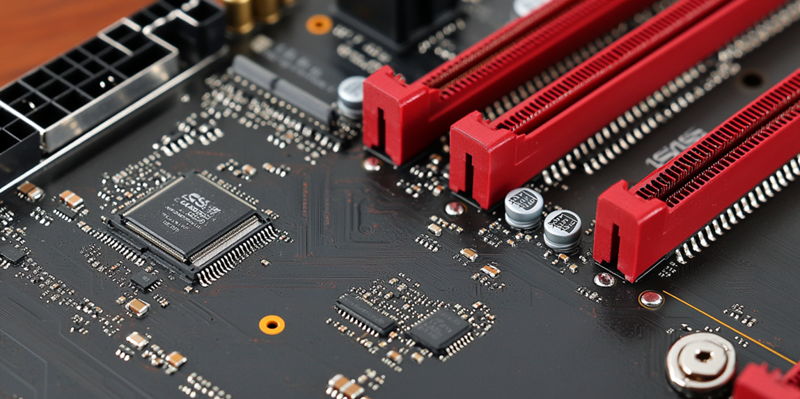ASUS has always been at the forefront of innovation in the PC building industry, consistently pushing the boundaries of what’s possible with motherboard design. Recently, the company has been experimenting with a new concept that could revolutionize the way PC enthusiasts build their systems: Backside Timing Free (BTF) connectors. Unlike conventional motherboards that feature connectors on the front, ASUS’s BTF design relocates all connectors to the back. But what does this mean for the future of PC building, and is it a game-changer or just a novelty?
The Birth of BTF Design
ASUS first introduced the BTF concept with the TUF Gaming B760M-BTF motherboard, which quickly captured the attention of the PC building community. By moving all connectors to the back, ASUS created a sleek, minimalist motherboard that significantly improves cable management and overall aesthetics. This new approach wasn’t just limited to motherboards. ASUS also rolled out the ROG Strix RTX 4090 BTF graphics card, pushing the boundaries further.
However, implementing backside connector technology isn’t straightforward. It involves substantial technical challenges and requires careful consideration of manufacturing processes. Despite these hurdles, ASUS displayed commitment to refining the BTF design to provide an optimal user experience. The company used the initial success of the TUF Gaming B760M-BTF as a stepping stone to explore this innovative design further.
Competition and Industry Implications
ASUS isn’t the only player in this rapidly evolving arena. Other major manufacturers like MSI and Gigabyte have also shown interest in backside connector designs, signaling a broader industry shift. This competition is beneficial for consumers as it drives innovation and encourages manufacturers to develop more refined and user-friendly products.
The industry’s movement towards cleaner PC builds facilitated by backside connectors has significant implications. Improved cable management not only enhances the aesthetic appeal of PC cases but also positively impacts airflow, thus improving overall system performance. As more companies invest resources into developing BTF technology, we could soon see this design become a standard feature in high-end PC builds.
Challenges and Technical Complexities
While the BTF design offers many benefits, it also introduces a range of complexities. Relocating connectors to the back requires significant re-engineering of motherboard layouts. This shift can impact signal integrity and necessitate meticulous testing to ensure reliability. Additionally, manufacturing processes need to adapt to accommodate the new design, which could lead to production delays.
These challenges explain why ASUS has chosen not to include BTF designs in the initial roll-out of the Z890 motherboards. By prioritizing foundational and mainstream product reliability, ASUS can ensure they’re offering robust and dependable products before fully committing to the more intricate BTF designs.
Future of BTF Motherboards
The recent showcase of concept Z890 HERO motherboards at Computex 2024 highlighted ASUS’s ongoing work in this domain. These prototypes illustrate the company’s dedication to innovation, even if it takes time to bring such designs to market. The showcased models, including the ROG Maximus Z790 HERO-based CAMM II variant, offer a glimpse into what the future holds for PC builds.
Juan Jose Guerrero from ASUS North America underscored the company’s focus on pacing its development. By investing time in fine-tuning these complex designs, ASUS is laying the groundwork for future product launches that will likely set new standards for the industry.
Market Readiness and Consumer Reception
Despite the excitement around BTF technology, market readiness is a vital consideration. Consumers have shown interest in cleaner builds and improved cable management, but widespread adoption will depend on several factors, including price, availability, and compatibility with existing PC components.
ASUS’s cautious and calculated approach reflects an understanding of these market dynamics. By ensuring that their initial products meet rigorous standards, they can build consumer trust and gradually introduce more advanced designs.
Broader Industry Trends
ASUS has long been a leader in innovation within the PC building industry, continually pushing the limits of motherboard design. Recently, ASUS has been experimenting with a groundbreaking concept that has the potential to transform the way PC enthusiasts assemble their systems: Backside Timing Free (BTF) connectors. Traditional motherboards have connectors on the front, making cable management a challenge. However, the new BTF design relocates all connectors to the back of the motherboard, aiming to create a cleaner and more efficient build. This shift could simplify cable management, improve airflow, and enhance overall aesthetics.
This novel approach is generating a lot of buzz among PC builders and tech enthusiasts. Imagine a PC with no visible cables cluttering the interior, making for a sleeker, more professional look. While some might see this as merely a trendy gimmick, the practical benefits are hard to ignore. Better airflow leads to improved cooling performance, and easier cable management can reduce build time and frustration. As more details emerge, it will be interesting to see if BTF connectors become a new standard in motherboard design or remain a niche innovation for enthusiasts.

